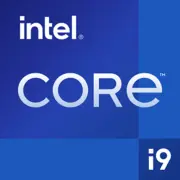Intel Core i9-12900F

Intel Core i9-12900F: A Hybrid Flagship for Professionals and Gamers
(Current as of March 2025)
Key Specifications: Architecture, Manufacturing Process, and Key Features
The Intel Core i9-12900F processor, released in late 2021, remains in demand in 2025 due to its hybrid Alder Lake architecture. It is the first mass-market CPU from Intel that combines Performance-cores (P-cores) and Efficiency-cores (E-cores).
- 16 cores (8P + 8E) and 24 threads: P-cores operate at a frequency of up to 5.0 GHz (Turbo Boost) and handle resource-intensive tasks, while E-cores (up to 3.8 GHz) optimize background processes.
- Intel 7 manufacturing process (10nm Enhanced SuperFin): Improved energy efficiency and transistor density.
- 30 MB L3 cache: Reduces data processing latency.
- Support for PCIe 5.0 and DDR5: Bandwidth of up to 128 GB/s (PCIe 5.0 x16) and up to 4800 MHz for DDR5.
Real-world Performance: In Geekbench 6, the CPU demonstrates 2542 points in single-threaded tests and 13884 points in multi-threaded tests. This makes it suitable for rendering, 4K gaming, and working with neural networks.
Compatible Motherboards: Sockets and Chipsets
The processor uses the LGA 1700 socket, which is supported by the Z690, B660, H610 chipsets.
- Z690 (from $180): For enthusiasts. Overclocking support, PCIe 5.0 x16, up to 4 slots for DDR5/DDR4. Examples: ASUS ROG Strix Z690-F ($280).
- B660 (from $120): Balanced price and functionality. No overclocking but includes PCIe 4.0. Suitable for builds with RTX 4070 level GPUs.
- H610 (from $70): Budget option. Limitation: 1 PCIe 4.0 x16 slot and DDR4-3200.
Important: Some boards only support DDR4 (e.g., ASUS Prime B660-Plus D4). For DDR5, look for the "D5" marking.
Memory: DDR4 vs. DDR5 — What to Choose?
The i9-12900F is compatible with both types, but the choice depends on budget and tasks:
- DDR5 (4800–6400 MHz): Suitable for professionals (rendering, ML). Price for 32 GB — $150–250.
- DDR4 (3200–3600 MHz): Up to 40% savings. 32 GB will cost $80–120.
In Practice: In gaming, the difference between DDR4 and DDR5 is about 5-10% (e.g., in Cyberpunk 2077 at 1440p). For 8K video editing, DDR5 will reduce export time by 15–20%.
Power Supply: How Many Watts Do You Need?
The official TDP of the processor is 65 W, but the peak power (PL2) reaches 180 W. Recommendations:
- With a discrete GPU (e.g., RTX 4080): A power supply of at least 750 W (preferably 80 Plus Gold/Platinum). Example: Corsair RM750x ($120).
- Without a high-end GPU: 550–650 W is sufficient (Cooler Master MWE Gold 650W — $90).
Tip: Avoid cheap power supplies without certifications — they mayoperate unstably under load.
Pros and Cons of the i9-12900F
Advantages:
- High single-threaded performance (gaming, Photoshop).
- Energy efficiency under base load.
- Support for DDR5 and PCIe 5.0 (future-proofing).
Disadvantages:
- Requires an expensive cooling solution (e.g., NZXT Kraken X63 — $130).
- No integrated graphics (unlike the i9-12900K).
- DDR5 and motherboards for it are more expensive than their DDR4 counterparts.
Use Cases: Who is it Suitable For?
1. Gamers: Paired with RTX 4070 Ti, it delivers 120+ FPS at 1440p (The Witcher 4, Starfield).
2. Content Creators: Renders in Blender 30% faster than the i7-12700K.
3. Streamers: 24 threads handle encoding and gaming simultaneously.
4. Engineers: Calculations in MATLAB or AutoCAD are performed seamlessly.
Example: Editing a 10-minute 4K video (DaVinci Resolve) takes about 12 minutes versus 18 with the Ryzen 7 5800X.
Comparison with Competitors
- AMD Ryzen 9 5900X (12 cores, $350 in 2025): Falls short in single-threaded tasks (Geekbench 6 Single Core — 2100) but is cheaper.
- AMD Ryzen 7 7800X3D (8 cores, $400): Better in gaming due to 3D V-Cache but weaker in multi-threaded scenarios.
- Intel Core i7-13700K ($380): Newer but more expensive. Performance gain is only 10-15%.
Conclusion: The i9-12900F is advantageous at a price of up to $300 (new) as a balance between price and power.
Practical Assembly Tips
1. Cooling: Minimum — tower cooler (DeepCool AK620 — $60), optimal — 240 mm liquid cooling.
2. Case: Good ventilation (Lian Li Lancool III — $140).
3. Storage: PCIe 4.0 NVMe (Samsung 990 Pro 1TB — $120) for maximum speed.
4. BIOS: Update to the latest version for stability and Windows 12 support.
Final Verdict: Who Should Buy the i9-12900F in 2025?
This processor is suitable for:
- Gamers looking to save on the CPU to invest more in a GPU.
- Professionals needing multi-threading capabilities without overspending on the latest models.
- Enthusiasts experimenting with DDR5 and PCIe 5.0.
Price: The new i9-12900F in 2025 is priced at $280–320, making it one of the best choices in the "upper mid-range" segment. However, if your budget allows, consider the i7-14700K ($370) or Ryzen 9 7900 ($400) for a more long-term perspective.
This article is current as of March 2025. Prices and availability may change.
Basic
CPU Specifications
Memory Specifications
Miscellaneous
Benchmarks
Compared to Other CPU
Share in social media
Or Link To Us
<a href="https://cputronic.com/cpu/intel-core-i9-12900f" target="_blank">Intel Core i9-12900F</a>